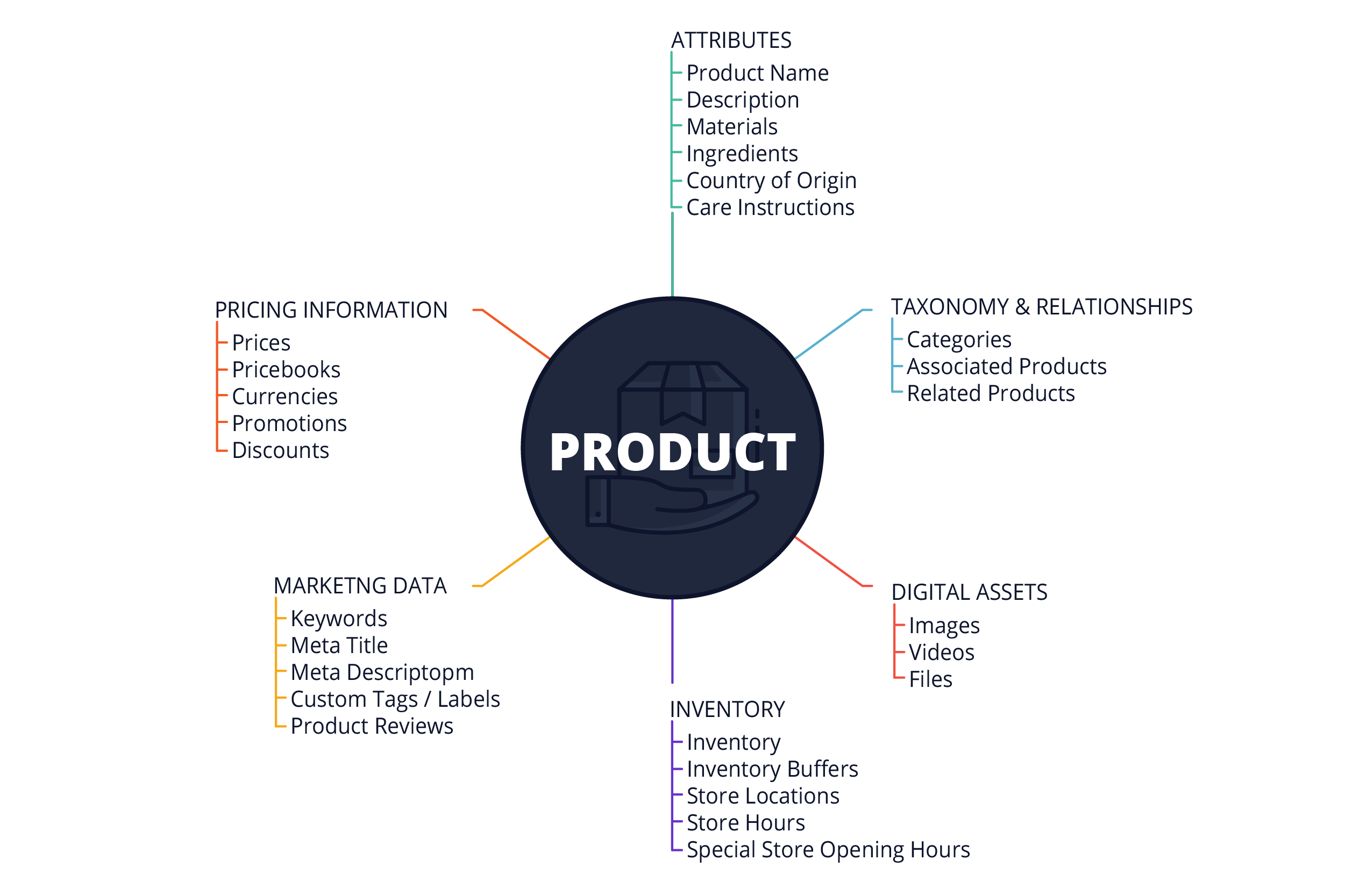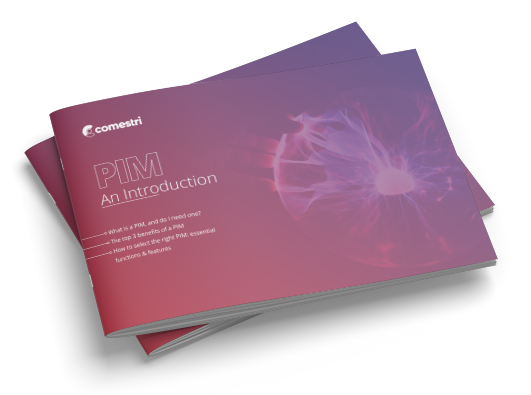What Is A PIM?
PIM DEFINITION
If you’re involved in retail or ecommerce, chances are you’ve heard of a PIM. In this article, we’ll cover a PIM definition, as well as why you need one and how it can help grow your ecommerce business. A PIM definition should help you understand the tech behind some of the world’s greatest retailers, and what makes them so successful!
The global product information management (PIM) market reached a value of US$ 10.5 Billion in 2021. IMARC Group expects the market to reach US$ 20.2 Billion by 2027, exhibiting a CAGR of 11.47% during 2022-2027.
What is Product Information Management?
A PIM (or Product Information Management) software environment is the central hub for all product information for an ecommerce business. The PIM holds all required product information in a logical and efficient structure, allowing retailers to enrich it and publish it across their entire ecommerce network.

By definition, a PIM system should hold:
Attributes
- Product name
- Description
- Materials
- Ingredients
- Country of origin
- Care instructions
Pricing Information
- Prices
- Pricebooks
- Currencies
- Promotions
- Discounts
Taxonomy & Relationships
- Categories
- Associated products
- Marketing Data
Keywords
- Meta title
- Meta description
- Custom tags / labels
- Product reviews
- Digital Assets
Images
- Videos
- Files
- Inventory
Inventory
- Inventory buffers
- Store locations
- Store hours
- Special store opening hours
What does a PIM System do?
A PIM’s primary use is to hold, enrich and manage different types of data. These can include:
Technical Data
Including specifications on size, colour, material, weight, etc.
Emotional Data
Including detailed product descriptions and imagery that facilitates emotional connections.
Usage Data
Including descriptions of where, when and how to use the product.
A good PIM definition is a place to store product data in a logical, structured format, making updates and automation easy. Product data is stored intuitively; new products are added with ease and publishing product data is simple. Sell more with next to no manual processes.
As the central source of product data truth, a PIM connects to all essential business systems. Data can be imported from other systems (e.g. ERP, suppliers, etc), enriched, optimised and exported back out to sales channels, marketplaces, BI tools, and many more.
Many retailers are still managing their data using spreadsheets. Unsurprisingly, data errors and inconsistencies are commonplace. The manual tweaks and distribution required from data kept in spreadsheets will inevitably result in human error. According to Gartner, this kind of poor data quality is responsible for an average of $15 million a year in losses.
Do I need a PIM Solution for my Ecommerce Business?
The short answer: yes. If you’re working with 1,000+ SKUs, selling on multiple marketplaces and looking to integrate your product data with sales and marketing channels, a PIM is essential for your ecommerce business.
PIM software makes ecommerce easy. Launch new products seamlessly, expand into new markets and test different sales channels without costly and lengthy integrations.
Your chosen ecommerce platform is a good entry-level PIM; if you’re just selling on your own ecommerce site and only need simple categorization, it will be sufficient. It’s time to start looking for an external PIM to integrate when:

You’re ready to up your customer experience game
You need multiple categorisation levels; you’d like your customers to be able to narrow down their product search further and find exactly what they’re looking for.
Spreadsheets are literally driving you mad
Chasing product data siloed across your organisation and trying to stitch it all together? There is an easier way! Say goodbye to spreadsheets with A PIM solution.


Failure to launch quickly
Are your products channel-ready? Is your product data in the right format to be both imported and exported from connected channels? A PIM for ecommerce can get you channel-ready fast!
Top Benefits of a PIM Tool
- One data set for multiple sites
If you’re selling internationally and managing multiple ecommerce sites, a PIM is your central hub for all product data. Hold internationalised data – including language, currency, imagery, and more – for each product in the one PIM.
- Boost searchability, reduce returns and delivery a remarkable experience
Give customers an exceptional experience and help them find exactly what they’re looking for. A PIM turns product data into rich product information, allowing customers to narrow down their search and understand exactly what they’re purchasing.
- Find new customers, locally or abroad
A PIM can connect to your customers wherever they decide to shop. Whether it be a new marketplace locally, or international sales channel, your PIM has you covered. Test new markets or move distressed stock; synchronise your inventory and pricing across all channels for a true omnichannel experience.
- Set the foundations for the future of retail
Centralised, quality data in your PIM will set you up for future success. AI, personalisation, VR, and more all require product data – easily connect your PIM and you’re good to go!
PIM FAQs
1. What is a PIM definition?
Wikipedia defines a PIM (Product information management)as: the process of managing all the information required to market and sell products through distribution channels.
PIM Software is a central hub that holds product data, and is the single source of product truth for an ecommerce organisation. It connects to all essential business systems, marketplaces, sales channels, marketing and social.
2. What information does a PIM hold?
Product data held in the PIM is essential to categorising, filtering and searching products. As well as technical data (name, description, images, etc), a PIM holds attributes. These attributes are used for filtering and searching, allowing customers to narrow down their results and find exactly what they’re looking for:

Vulputate gravida nibh egestas.
As you can see from the Lorna Jane example to the left, all products in this collection are categorised as ‘Loungewear’.
Vulputate gravida nibh egestas.
Each dropdown in the example above are attributes assigned to each product.

3. What systems can integrate with a PIM?
A PIM connects to all essential business systems, and can import, transform and export data.
Import products, inventory, prices, customer data and more from virtually any cloud-based external service that supports industry-standard file formats for file exchange. Data is transformed into the format required for your PIM, ensuring data consistency and accurate inventory levels.
Export information stored in your PIM to any external cloud-based service (ecommerce platforms, marketplaces, affiliate / marketing feeds, business intelligence tools, ERP systems and more). Configure the data into the format required for each external system with ease.
4. How does a PIM work with Magento?
Magento (Adobe Commerce) is a fantastic ecommerce platform with some amazing, user-friendly and intuitive features,however it falls short on the robust product information management capabilities that are needed for today’s digital consumer.
In a digital environment, customers can’t use their senses to experience the product prior to purchasing; they’re solely reliant on product data to make an informed buying decision.
Comestri’s PIM integration with Magento allows retailers to take their product listings to the next level, with support for diverse product models through a combination of Magento Configurable, Simple and Grouped Products for optimal flexibility. The integration offers multi-store, multi-language and multi-currency support, meaning you can manage products for multiple websites and multiple countries within the one platform.
5. How does a PIM work with Shopify?
Manage your products like a pro with a PIM integration with Shopify. List both multi-level products (products with variants) and simple products (SKUs) on your Shopify store, and use Comestri’s Automation Engine to create rules that filter the products to sell in your Shopify store, marketplaces or other sales channels.
Extend the functionality of your Shopify store:
- Add Shopify Options, Tags and Meta fields to products to further enrich your products.
- Add additional search-relevant details (e.g. handle, meta description, meta title) for enhanced SEO.
- Centralise your inventory across multiple Shopify sites and sales channels in Comestri’s Product Manager (PIM) and prevent sell-outs
Let’s work together.
Keen to unify your inventory? Book a demonstration
with our team and discover how Comestri can transform your business today.


